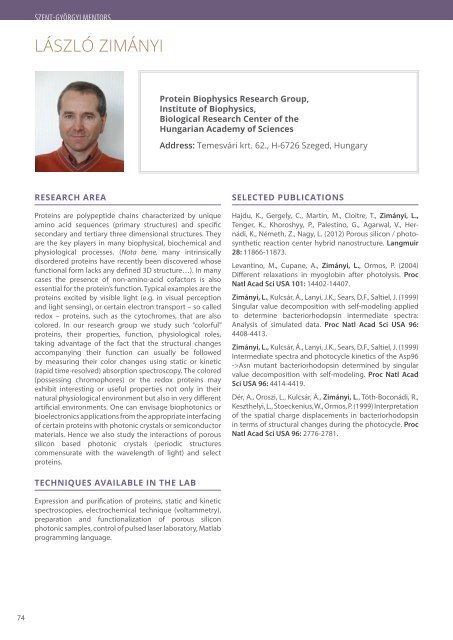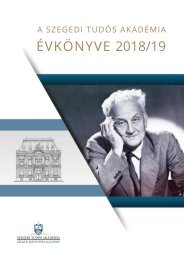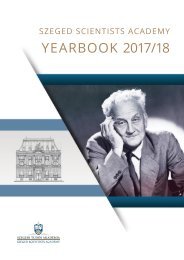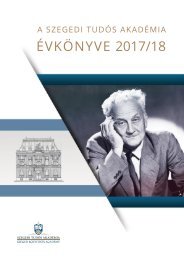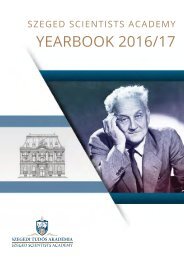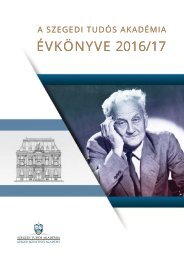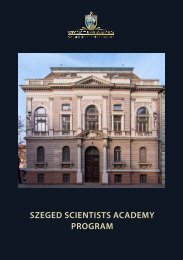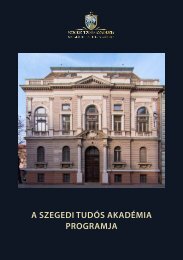Create successful ePaper yourself
Turn your PDF publications into a flip-book with our unique Google optimized e-Paper software.
SZENT-GYÖRGYI MENTORS<br />
LÁSZLÓ ZIMÁNYI<br />
Protein Biophysics Research Group,<br />
Institute of Biophysics,<br />
Biological Research Center of the<br />
Hungarian Academy of Sciences<br />
Address: Temesvári krt. 62., H-6726 Szeged, Hungary<br />
RESEARCH AREA<br />
Proteins are polypeptide chains characterized by unique<br />
amino acid sequences (primary structures) and specific<br />
secondary and tertiary three dimensional structures. They<br />
are the key players in many biophysical, biochemical and<br />
physiological processes. (Nota bene, many intrinsically<br />
disordered proteins have recently been discovered whose<br />
functional form lacks any defined 3D structure…). In many<br />
cases the presence of non-amino-acid cofactors is also<br />
essential for the protein’s function. Typical examples are the<br />
proteins excited by visible light (e.g. in visual perception<br />
and light sensing), or certain electron transport – so called<br />
redox – proteins, such as the cytochromes, that are also<br />
colored. In our research group we study such “colorful”<br />
proteins, their properties, function, physiological roles,<br />
taking advantage of the fact that the structural changes<br />
accompanying their function can usually be followed<br />
by measuring their color changes using static or kinetic<br />
(rapid time-resolved) absorption spectroscopy. The colored<br />
(possessing chromophores) or the redox proteins may<br />
exhibit interesting or useful properties not only in their<br />
natural physiological environment but also in very different<br />
artificial environments. One can envisage biophotonics or<br />
bioelectronics applications from the appropriate interfacing<br />
of certain proteins with photonic crystals or semiconductor<br />
materials. Hence we also study the interactions of porous<br />
silicon based photonic crystals (periodic structures<br />
commensurate with the wavelength of light) and select<br />
proteins.<br />
SELECTED PUBLICATIONS<br />
Hajdu, K., Gergely, C., Martin, M., Cloitre, T., Zimányi, L.,<br />
Tenger, K., Khoroshyy, P., Palestino, G., Agarwal, V., Hernádi,<br />
K., Németh, Z., Nagy, L. (2012) Porous silicon / photosynthetic<br />
reaction center hybrid nanostructure. Langmuir<br />
28: 11866-11873.<br />
Levantino, M., Cupane, A., Zimányi, L., Ormos, P. (2004)<br />
Different relaxations in myoglobin after photolysis. Proc<br />
Natl Acad Sci USA 101: 14402-14407.<br />
Zimányi, L., Kulcsár, Á., Lanyi, J.K., Sears, D.F., Saltiel, J. (<strong>19</strong>99)<br />
Singular value decomposition with self-modeling applied<br />
to determine bacteriorhodopsin intermediate spectra:<br />
Analysis of simulated data. Proc Natl Acad Sci USA 96:<br />
4408-4413.<br />
Zimányi, L., Kulcsár, Á., Lanyi, J.K., Sears, D.F., Saltiel, J. (<strong>19</strong>99)<br />
Intermediate spectra and photocycle kinetics of the Asp96<br />
->Asn mutant bacteriorhodopsin determined by singular<br />
value decomposition with self-modeling. Proc Natl Acad<br />
Sci USA 96: 4414-44<strong>19</strong>.<br />
Dér, A., Oroszi, L., Kulcsár, Á., Zimányi, L., Tóth-Boconádi, R.,<br />
Keszthelyi, L., Stoeckenius, W., Ormos, P. (<strong>19</strong>99) Interpretation<br />
of the spatial charge displacements in bacteriorhodopsin<br />
in terms of structural changes during the photocycle. Proc<br />
Natl Acad Sci USA 96: 2776-2781.<br />
TECHNIQUES AVAILABLE IN THE LAB<br />
Expression and purification of proteins, static and kinetic<br />
spectroscopies, electrochemical technique (voltammetry),<br />
preparation and functionalization of porous silicon<br />
photonic samples, control of pulsed laser laboratory, Matlab<br />
programming language.<br />
74


